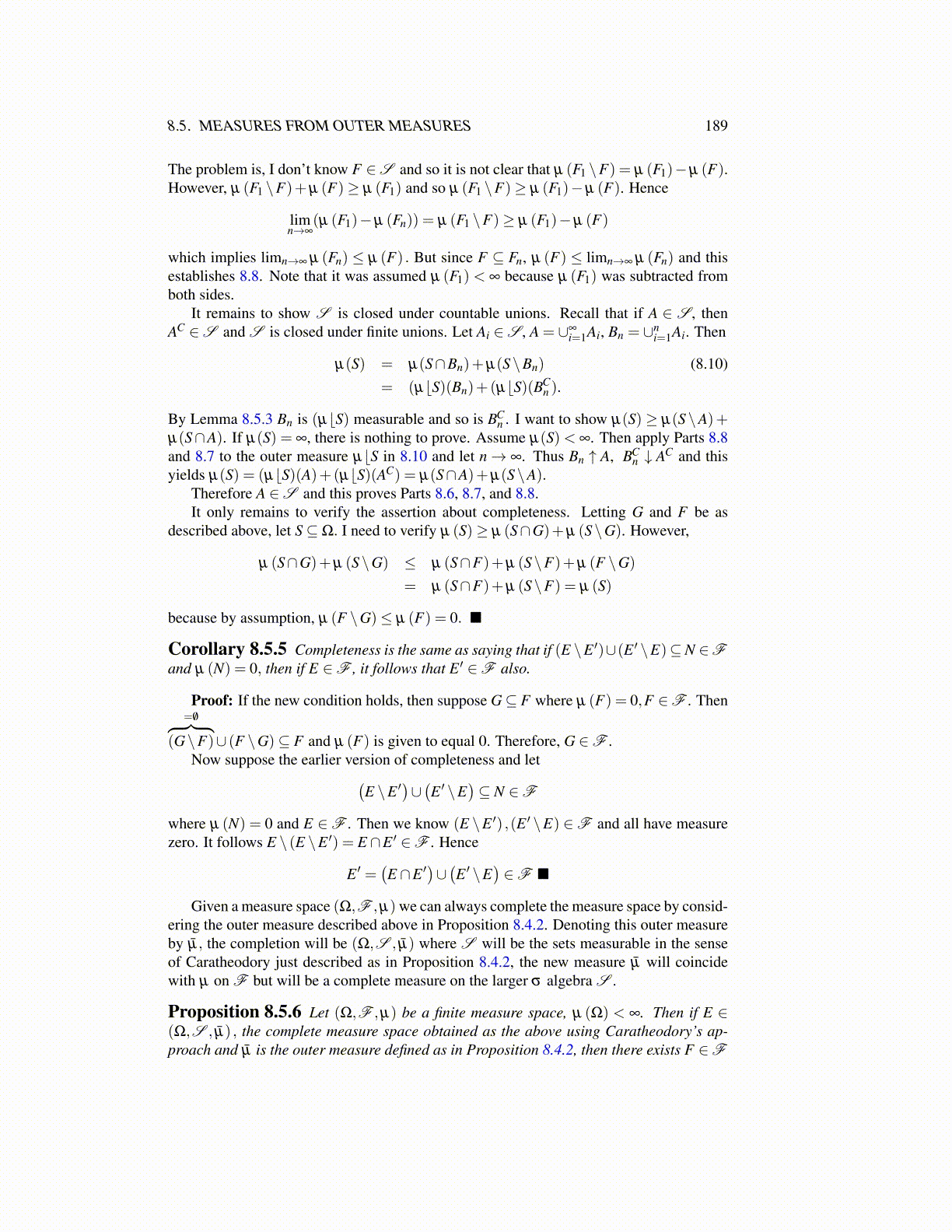
8.5. MEASURES FROM OUTER MEASURES 189
The problem is, I don’t know F ∈S and so it is not clear that µ (F1 \F) = µ (F1)−µ (F).However, µ (F1 \F)+µ (F)≥ µ (F1) and so µ (F1 \F)≥ µ (F1)−µ (F). Hence
limn→∞
(µ (F1)−µ (Fn)) = µ (F1 \F)≥ µ (F1)−µ (F)
which implies limn→∞ µ (Fn) ≤ µ (F) . But since F ⊆ Fn, µ (F) ≤ limn→∞ µ (Fn) and thisestablishes 8.8. Note that it was assumed µ (F1) < ∞ because µ (F1) was subtracted fromboth sides.
It remains to show S is closed under countable unions. Recall that if A ∈ S , thenAC ∈S and S is closed under finite unions. Let Ai ∈S , A = ∪∞
i=1Ai, Bn = ∪ni=1Ai. Then
µ(S) = µ(S∩Bn)+µ(S\Bn) (8.10)= (µ⌊S)(Bn)+(µ⌊S)(BC
n ).
By Lemma 8.5.3 Bn is (µ⌊S) measurable and so is BCn . I want to show µ(S) ≥ µ(S \A)+
µ(S∩A). If µ(S) = ∞, there is nothing to prove. Assume µ(S)< ∞. Then apply Parts 8.8and 8.7 to the outer measure µ⌊S in 8.10 and let n→ ∞. Thus Bn ↑ A, BC
n ↓ AC and thisyields µ(S) = (µ⌊S)(A)+(µ⌊S)(AC) = µ(S∩A)+µ(S\A).
Therefore A ∈S and this proves Parts 8.6, 8.7, and 8.8.It only remains to verify the assertion about completeness. Letting G and F be as
described above, let S⊆Ω. I need to verify µ (S)≥ µ (S∩G)+µ (S\G). However,
µ (S∩G)+µ (S\G) ≤ µ (S∩F)+µ (S\F)+µ (F \G)
= µ (S∩F)+µ (S\F) = µ (S)
because by assumption, µ (F \G)≤ µ (F) = 0. ■
Corollary 8.5.5 Completeness is the same as saying that if (E \E ′)∪(E ′ \E)⊆N ∈Fand µ (N) = 0, then if E ∈F , it follows that E ′ ∈F also.
Proof: If the new condition holds, then suppose G⊆ F where µ (F) = 0,F ∈F . Then= /0︷ ︸︸ ︷
(G\F)∪ (F \G)⊆ F and µ (F) is given to equal 0. Therefore, G ∈F .Now suppose the earlier version of completeness and let(
E \E ′)∪(E ′ \E
)⊆ N ∈F
where µ (N) = 0 and E ∈F . Then we know (E \E ′) ,(E ′ \E) ∈F and all have measurezero. It follows E \ (E \E ′) = E ∩E ′ ∈F . Hence
E ′ =(E ∩E ′
)∪(E ′ \E
)∈F ■
Given a measure space (Ω,F ,µ) we can always complete the measure space by consid-ering the outer measure described above in Proposition 8.4.2. Denoting this outer measureby µ̄, the completion will be (Ω,S , µ̄) where S will be the sets measurable in the senseof Caratheodory just described as in Proposition 8.4.2, the new measure µ̄ will coincidewith µ on F but will be a complete measure on the larger σ algebra S .
Proposition 8.5.6 Let (Ω,F ,µ) be a finite measure space, µ (Ω) < ∞. Then if E ∈(Ω,S , µ̄) , the complete measure space obtained as the above using Caratheodory’s ap-proach and µ̄ is the outer measure defined as in Proposition 8.4.2, then there exists F ∈F